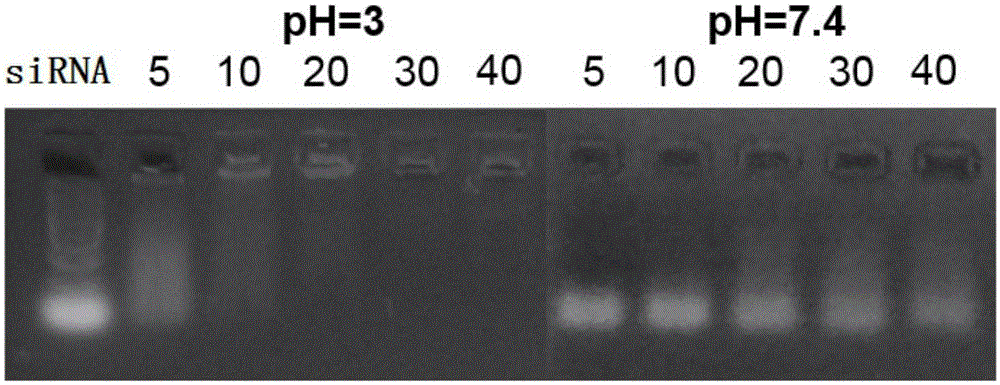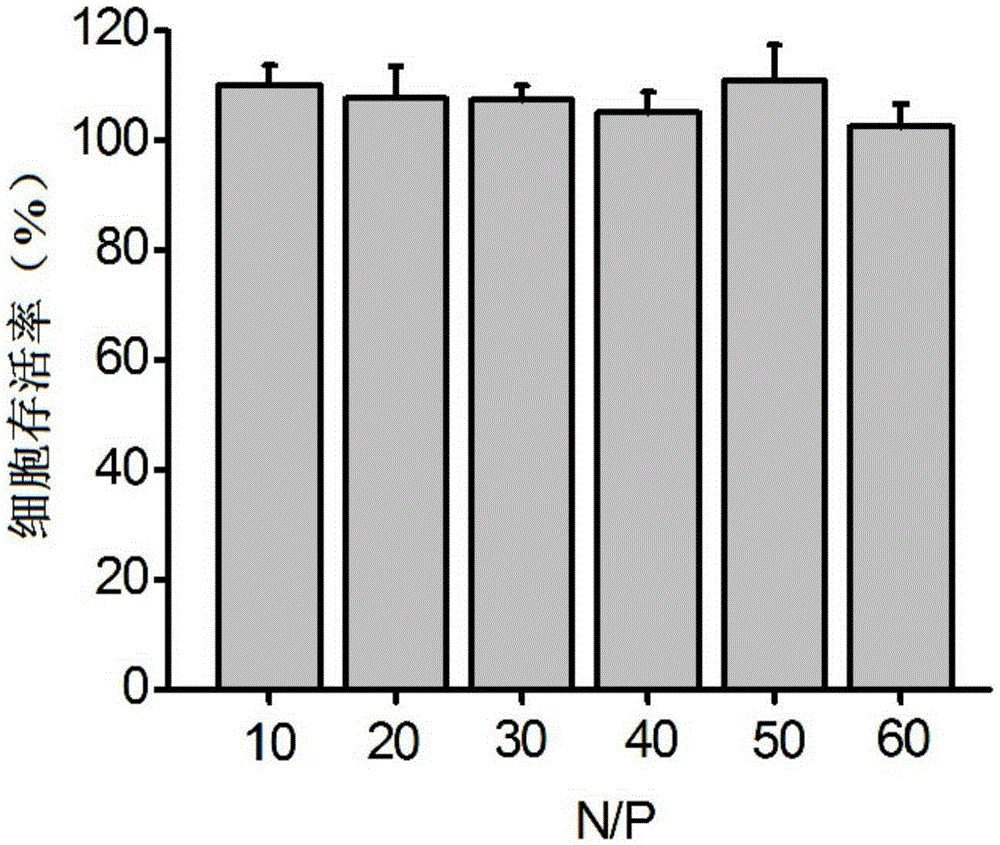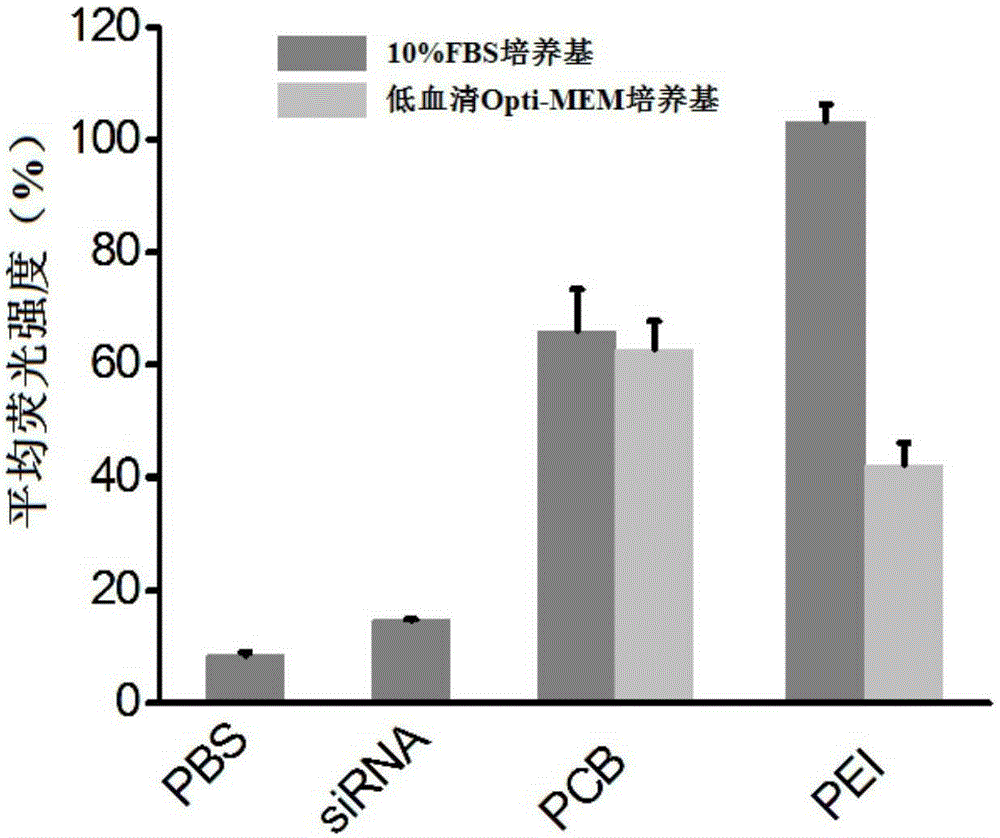Polycarboxyl glycine betaine gene transfection preparation as well as preparation method and application thereof
A polycarboxybetaine and gene transfection technology, which can be applied to other methods of inserting foreign genetic materials, gene therapy, anti-infective drugs, etc. The effect of serum stability
- Summary
- Abstract
- Description
- Claims
- Application Information
AI Technical Summary
Problems solved by technology
Method used
Image
Examples
Embodiment 1
[0045] The preparation of embodiment 1 polycarboxybetaine gene transfection preparation
[0046] 1) Preparation of compound buffer: weigh sodium acetate (16.406g, 0.2mol) and dissolve it in 1L water to obtain 0.2mol / L sodium acetate mother liquor, weigh acetic acid (18.015g, 0.3mol) and dissolve it in 1L water to obtain 0.3mol / L The acetic acid mother liquor of L, gets the sodium acetate mother liquor of 49mL and the acetic acid mother liquor of 51mL and mixes, and obtains the acetic acid-sodium acetate composite buffer solution that pH is 4.6;
[0047] 2) Prepare the blend solution of polycarboxybetaine polymer and complex buffer: weigh 1mgCBD-PCB 20 Dissolve in 0.5mL of acetic acid-sodium acetate complex buffer solution, the dissolution time is 0.5h, and the temperature is 20°C;
[0048] 3) Prepare a compound solution formed by compounding the blend solution and the nucleic acid to be transfected: take 0.04 mL of the blend solution obtained in step (2), dissolve 10.00 μg ...
Embodiment 2
[0050] The preparation of embodiment 2 polycarboxybetaine gene transfection preparation
[0051] 1) Preparation of composite buffer: Weigh disodium hydrogen phosphate (28.392g, 0.2mol) and dissolve it in 1L water to obtain 0.2mol / L disodium hydrogen phosphate mother liquor, weigh acetic acid (35.994g, 0.3mol) and dissolve it in 1L water To obtain 0.3mol / L sodium dihydrogen phosphate mother liquor, get 8mL of disodium hydrogen phosphate mother liquor and 92mL of sodium dihydrogen phosphate mother liquor and mix to obtain a disodium hydrogen phosphate-sodium dihydrogen phosphate composite buffer solution with a pH of 5.8;
[0052] 2) Prepare the blend solution of polycarboxybetaine polymer and complex buffer: weigh 1mgCBD-PCB 20 Dissolve in 1.0mL of acetic acid-sodium acetate complex buffer solution for 1 hour at a temperature of 37°C;
[0053] 3) Prepare the compound solution formed by compounding the blend solution and the nucleic acid to be transfected: take 0.08 mL of the...
Embodiment 3
[0055] The preparation of embodiment 3 polycarboxybetaine gene transfection preparation
[0056] 1) Preparation of compound buffer solution: Weigh potassium hydrogen phthalate (40.844g, 0.2mol) and dissolve it in 1L of water to obtain 0.2mol / L disodium hydrogen phosphate potassium hydrogen phthalate mother liquor, take 5mL of phthalic acid Potassium hydrogen and 2.022mL of 0.2mol / L hydrochloric acid were mixed, and water was added to make the volume to 20mL to obtain a potassium hydrogen phthalate-hydrochloric acid composite buffer solution with a pH of 3.0;
[0057] 2) Prepare a blend solution of polycarboxybetaine polymer and complex buffer: weigh 1 mg of cholesterol-PCB 20 Dissolve in 1.0mL acetic acid-sodium acetate complex buffer solution, the dissolution time is 3h, and the temperature is 25°C;
[0058] 3) Prepare a compound solution formed by compounding the blend solution and the nucleic acid to be transfected: take 0.08 mL of the blend solution obtained in step (2)...
PUM
 Login to View More
Login to View More Abstract
Description
Claims
Application Information
 Login to View More
Login to View More - R&D
- Intellectual Property
- Life Sciences
- Materials
- Tech Scout
- Unparalleled Data Quality
- Higher Quality Content
- 60% Fewer Hallucinations
Browse by: Latest US Patents, China's latest patents, Technical Efficacy Thesaurus, Application Domain, Technology Topic, Popular Technical Reports.
© 2025 PatSnap. All rights reserved.Legal|Privacy policy|Modern Slavery Act Transparency Statement|Sitemap|About US| Contact US: help@patsnap.com



